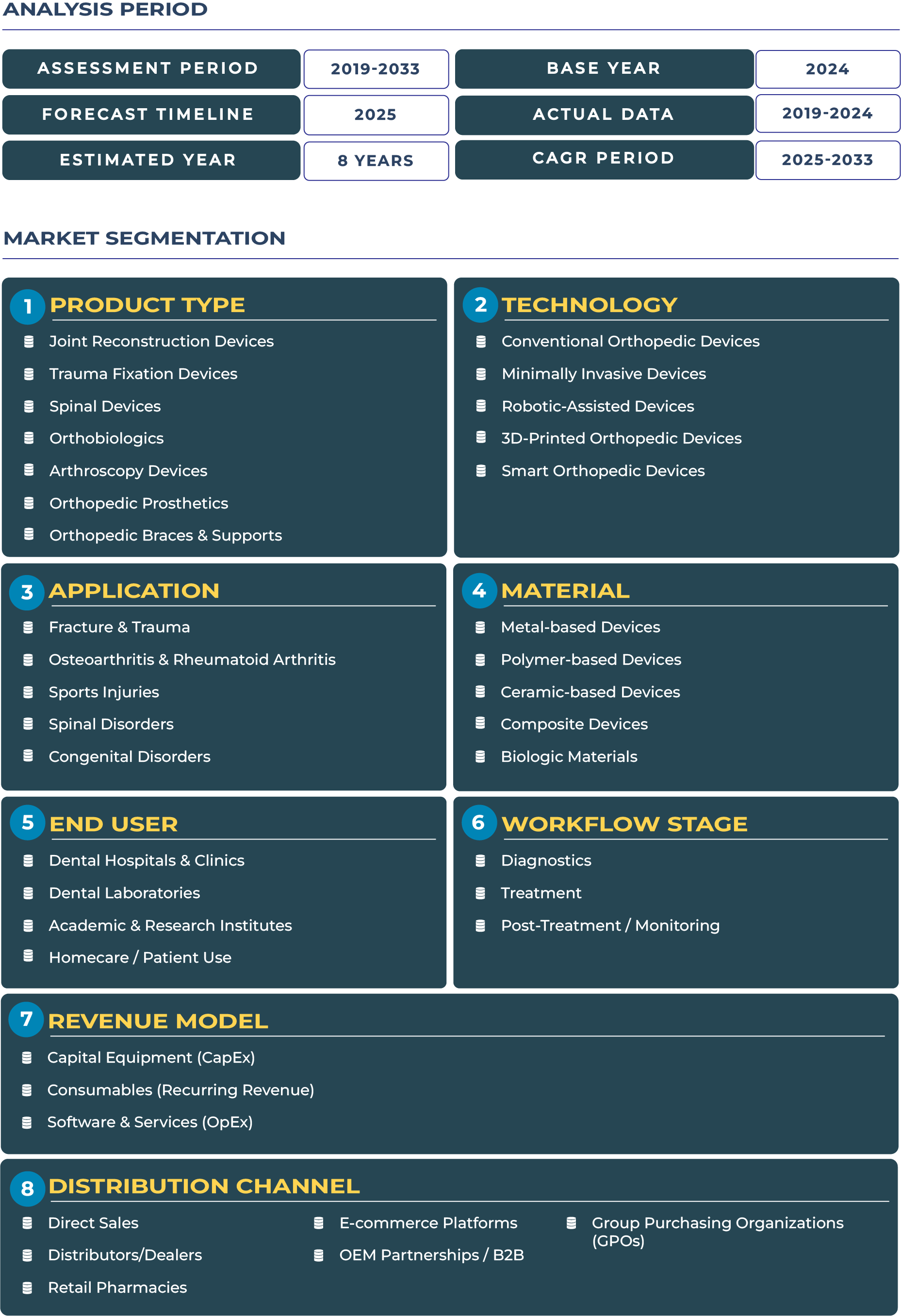Report Format:
![]()
![]() |
Pages: 110+
|
Pages: 110+
Oman Orthopedic Devices Market Outlook: Public Healthcare Expansion Driving Specialized Care Demand
Oman’s healthcare sector is undergoing steady transformation as state-driven investments strengthen hospital infrastructure and expand access to specialized care. Orthopedic devices are an important segment within this evolution, particularly as musculoskeletal disorders, joint-related diseases, and trauma injuries continue to rise. The orthopedic devices market in Oman reflects a high-dependence on hospital-based demand, with imports of advanced trauma fixation devices, orthopedic prosthetics, and spinal solutions supporting both surgical capacity and long-term rehabilitation. While smaller in scale compared to neighboring Gulf states, Oman Orthopedic Devices ecosystem benefits from targeted public funding and strategic upgrades across provincial and urban healthcare facilities, positioning it for gradual but resilient growth.
The orthopedic devices market in Oman is projected to reach USD 24.2 million in 2025 and expand to USD 33.5 million by 2033. This growth is anchored in the government’s long-term commitment to strengthening healthcare access through new hospitals and expanded specialty wings in Muscat and provincial regions. Public hospitals remain the backbone of demand, particularly for trauma fixation systems and joint reconstruction devices, where surgical volumes are rising in tandem with lifestyle-related orthopedic conditions. Despite regional geopolitical volatility and the fiscal pressure of fluctuating oil prices, Oman has prioritized healthcare in its Vision 2040 program. As a result, the orthopedic devices sector continues to attract multinational suppliers seeking stable mid-tier markets supported by central procurement policies and a growing emphasis on advanced surgical solutions.
Drivers & Restraints: Opportunities in Steady Growth Amid Structural Market Constraints
Public Investment and Niche Growth Drivers Strengthening the Orthopedic Devices Industry
Oman Orthopedic Devices industry is shaped by consistent government investments that prioritize infrastructure expansion and modernized surgical care. The Ministry of Health Oman has rolled out initiatives to strengthen hospital networks, with orthopedic wards benefiting from new equipment allocations. Focused upgrades in provincial hospitals ensure that advanced procedures, including spinal surgeries and arthroscopy, are no longer limited to Muscat. Tourism growth in niche wellness and rehabilitation services is also indirectly supporting demand for orthopedic implants and post-trauma recovery devices. With rising cases of road traffic accidents—a key contributor to trauma-related demand—the adoption of fixation and reconstructive devices continues to expand steadily in the public sector.
Challenges in Procurement, Private Sector Limitations, and Market Scale
While Oman Orthopedic Devices market is on an upward trajectory, several structural barriers limit rapid expansion. Procurement is highly centralized, with decisions tied closely to the Ministry of Health, reducing flexibility for hospitals to independently adopt premium implants or niche biologics. The private healthcare sector remains limited in size, curbing opportunities for boutique orthopedic practices or premium device installations. Budget constraints, particularly during periods of lower oil revenues, also restrict the pace of high-end equipment acquisitions. Moreover, the country’s small market size means that global orthopedic companies often prioritize larger GCC markets, requiring innovative financing and leasing models to improve device penetration in Oman.
Trends & Opportunities: Modernization, Selective Private Expansion, and Emerging Delivery Models
Key Trends Shaping the Orthopedic Devices Ecosystem in Oman
Several trends are reshaping Oman Orthopedic Devices market, particularly in urban healthcare hubs. Planned hospital upgrades in Muscat and regional centers are equipping surgical wings with advanced joint replacement technologies and biologics-supported healing devices. Selective private projects, often catering to higher-income groups, are introducing boutique orthopedic services, though these remain limited in number. Telehealth adoption, driven by the pandemic and ongoing digital health initiatives, is extending patient engagement and post-surgical monitoring, creating additional opportunities for orthopedic rehabilitation and device integration into outpatient care models.
Opportunities in Distribution, Leasing Models, and Pilot Initiatives
Oman Orthopedic Devices sector presents promising opportunities for global manufacturers and regional distributors. Pilot projects in the capital provide entry points for advanced orthopedic prosthetics and arthroscopy solutions. Partnerships with regional distributors enhance access to smaller hospitals in provincial areas, addressing logistical barriers in medical device delivery. Leasing models and flexible financing arrangements are emerging as critical tools to overcome procurement hurdles, particularly for small-scale hospitals seeking high-cost implants or surgical robotics. With sustained public investments, companies that adapt to Oman’s structural realities while offering scalable solutions stand to gain long-term footholds in this steadily growing orthopedic devices ecosystem.
Competitive Landscape: Multinational Leaders Partnering with Oman’s Public Healthcare Sector
The competitive landscape of Oman Orthopedic Devices industry is marked by a reliance on international manufacturers and regional distributors. Companies such as Stryker, Zimmer Biomet, and Smith & Nephew maintain a strong presence through collaborations with Oman’s public hospitals and regional distributors. Strategies increasingly focus on providing leasing arrangements and training support to surgical teams, particularly for advanced spinal and trauma devices. Pilot initiatives in Muscat’s hospitals have introduced premium implants and biologics-based solutions, with local staff training programs ensuring sustained adoption. Global suppliers view Oman as a stable but mid-scale market, where partnerships with the Ministry of Health and flexible procurement approaches define long-term competitive advantage.







